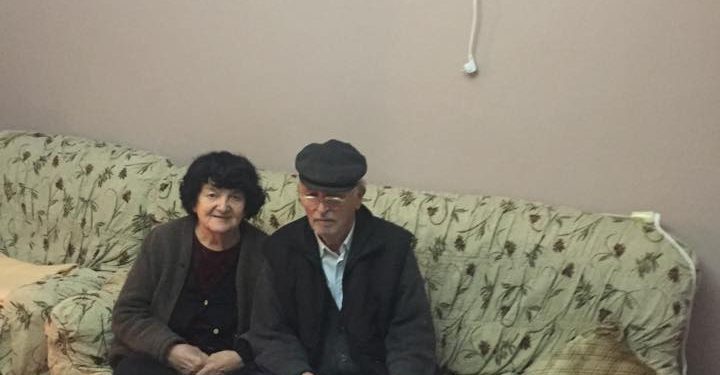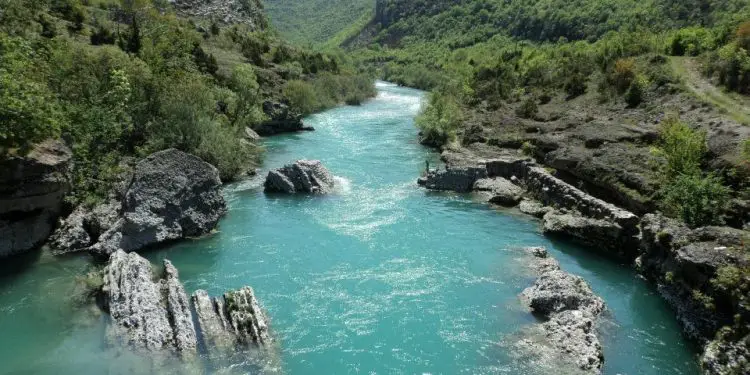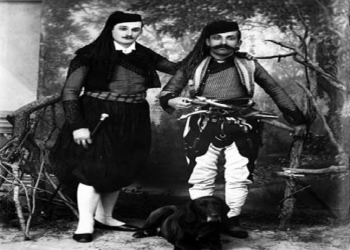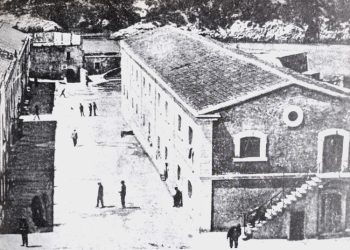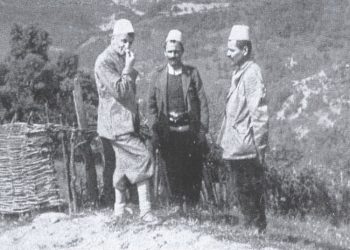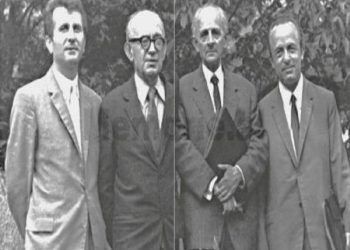Dashnor Kaloçi
Memorie.al publishes a report conducted in Tuz, Montenegro, where Vasel Margilaj, a pensioner and former history teacher, took over and managed to build a long road in the deep mountainous province of Triesi. His exclusive testimony for Memorie.al, for the great financial help of his compatriots from the USA, to the initial work of all family members, for which, Vaseli states: “After my idea was accepted, we decided to As we gathered to celebrate this, on March 14, 1992, about 80 people from Malësia e Madhe gathered at the men’s assembly at Tuzi school. Among those men, I can mention 20 of them, who was elected to the council that would deal with further proceedings for the construction of the road. They were: Sul Brahimi Krniq, Zef Nika Kalaj, Rrok Pjetri Gjocaj, Pjetër Gjoni Gorvokaj, Xhemal Rustaj Nikaj, Mark Zefi Dedëvukaj, Elez Ahmeti Gjokaj, Fadil Pepiqi, Nikoll Luca Marashaj, Mirash Gjoni Gjonaj, Zef Doka Dedivanaj Gjelosh Toma Gjeloshaj, Lek Gjoni Dedivanaj, Zef Kola Gjokaj, Gjeto Luli Gjokaj, Nosh Marku Lulgjuraj, Nikoll Prenka Lulgjuraj, Rrok Kola Stanaj and i Vasel Margilaj”.
As soon as you cross the border point of Hani i Hotit and enter the territory of Montenegro, leaving behind on the left the fabulous beauties of the shores of Lake Shkodra with the dense forest, which although on the eve of winter has not yet lost the greenery of its, after some strong turns, suddenly appear a wide and endless field extending to the horizon from the west. Borders in that area start there on the side of the highway leading to the town of Tuzi, which is located on the side of the railway and runs parallel to it, ending in the north with the town of Podgorica, and in the west, with the high mountains that divide it. field with the rocky coast of Montenegro. Tuzi’s first houses, some beautiful two- and three-story villas decorated with white stones and surrounded by spacious courtyards, trees, and decorative flowers, begin at the entrance to the national road, stretching on both sides of its, already occupied with several types of businesses. All of them are built with modern architecture and an urban plan, which can hardly be found even in the largest city here and there on the border. According to locals, that neighborhood with new houses and paved streets and alleys throughout its territory began to be built sometime in the late 1960s, when the Yugoslav state at the time gave it land for house building, many of the families of that province. Just before entering the center of the city of Tuzi, which is inhabited by a population of autochthonous Albanians of about 7000 inhabitants, we return to the left, where lies the famous bazaar of that city, which has been known for years as well as the bazaar of Milot or that of Roskovec. There you can find all kinds of goods, which are produced on almost all five continents of the world. Without having to stop the horn of that noisy market, which leaves nothing missing to those who are usually in all the cities of Albania, only with a quick look from the car, I notice that there the “law” is made by the goods ” Made in China ”. Where Chinese traders already with the appearance of Balkan businessmen, visually check some of the Albanians who have hired and their goods exhibited corner by corner of that market, where there are also parked cars with license plates of Tirana, Lezha, Shkodra and Malësia e great. Having no interest in what is happening there, we walk a few hundred meters further and stop at the horn of a three-story villa, which, like all of Tuzi’s other houses, is surrounded on all four sides by a courtyard, where it can you only find trees and decorative flowers. It is the home of the man we traveled from Tirana to meet. Vasel Margilaj, a former history teacher in some schools in Tuzi and Triesi of Malësia e Madhe (under Montenegro), with the generosity of the Albanian mountaineer, which on that side is more pronounced, with the characteristic expression, “Welcome God forbid ”, invites us inside, making all the customs that belong to distant friends. Afterward, the conversation continues about the purpose of our visit to his home: on the mountain road, Grudë-Selishtë-Trijesh, of 4.2, km., Which Vasel Margilaj, a former teacher and retired for two decades, took over and managed to was building in 1998. But where is that road, what was the reason for its construction, with what funding was it done and who worked on its construction? These are some of our questions, to which Vasel Margilaj gives answers slowly, putting in front of us some thick files with hundreds of pages of documents. In addition, he invites us to follow him, accompanying us in his car in the direction of Trijesh. “We’d better look at it instead,” he tells us. Driving his car towards that deep mountainous place, which this time became the subject of our reportage, he starts and tells us…
Vasel’s idea of the road
But why did Vasel Margilaj decide to embark on an almost impossible adventure, which had to do with the construction of that deep mountain road, and how did he first come up with the idea? In this regard, Vaseli told us: “For years I had been thinking about the construction of that road, having a number of reasons for that remote area, which was isolated and without communication with other areas of Malësia. I had a great desire to connect Trijeshi with Malësia, (the center in Tuz, Hot, Grudë, Kojë, and Ledinë), as this road did not exist at all and to move there, the highlanders were forced to walk or with horses. There have been many cases when women gave birth to their children on the way to the nearest hospital or even the sick who died on the way without being able to go to the hospital. One of those women who died on the way to the hospital was my mother. Another reason was the great difficulty of the children to go to school or the workers in their work. Also, a major obstacle was the communication with our brothers across the border in the Vermosh area, with whom only the Cem valley separated us. Based on what I said, the Trijeshas did not have the opportunity to participate in many occasions of joy, sorrow, or other social activities, where they were invited to go. Due to these many difficulties, Trijeshi was increasingly abandoned by its inhabitants, who came down to the city of Tuzi, or other places where they could make a better living. Based on these, I personally had several times made a written request to the relevant bodies and institutions in Podgorica, but they never gave me a positive response, as Podgorica did not want Tuzi to become a municipality. This is what Vasel Margilaj said, regarding the many reasons that forced him to undertake the very bold initiative for the construction of the mountain road in Qafën e Nogrivës, which the administrative bodies of Podgorica had refused several times.
Margilaj: my idea was supported by everyone
As was customary in matters relating to the life, future, and fate of the Trijeshas, his idea of building the road, Vasel Margilaj, he decided to discuss with the men of Malësia. But how did they receive his idea and suggestion for opening that road? Regarding this, Vaseli told us: “As a start, I wanted to say that: historically in Qafë i Nogrivës, the men of Gruda and Trijeshi have met and have made an agreement between them for everything that is good, both for good and for bad. for bad. In that place are the elders, who in most cases have ended up with humanity and glory for both sides. The men of Gruda and Trijeshi have grown old in this place with the Kanun of Lek Dukagjini and in these old people has been the mediator and our great writer, Father Anton Harapi, who has written the book “Andrra e Preteshit” for this. Based on these habits of our ancestors, on the issue of the road that bothered us a lot, we also decided to hold a meeting and give a solution to this problem. So after my idea was accepted, we decided to gather to grow old, and on March 14, 1992, about 80 people from Malësia e Madhe gathered at the men’s assembly at Tuzi school. Among those men, I can mention 20 of them, who was elected to the council that would deal with further proceedings for the construction of the road. They were: Sul Brahimi Krniq, Zef Nika Kalaj, Rrok Pjetri Gjocaj, Pjetër Gjoni Gorvokaj, Xhemal Rustaj Nikaj, Mark Zefi Dedëvukaj, Elez Ahmeti Gjokaj, Fadil Pepiqi, Nikoll Luca Marashaj, Mirash Gjoni Gjonaj, Zef Doka Dedivanaj Gjelosh Toma Gjeloshaj, Lek Gjoni Dedivanaj, Zef Kola Gjokaj, Gjeto Luli Gjokaj, Nosh Marku Lulgjuraj, Nikoll Prenka Lulgjuraj, Rrok Kola Stanaj and I Vasel Margilaj. In that council where I was elected chairman, there were representatives from all over Malësija, Hoti, Gruda, Koja, Luhari, and Trijeshi. In my speech, I outlined some of the reasons for building that road, the route of which would pass through the slopes of Mount Suka (which are constantly battered by sunlight), and the wind that would blow from the south, would help melt snow and ice. This decision and my speech were greeted with applause by all those present who were present at that gathering, as well as by all the people of Malësia, who became acquainted that day with the decision taken there. The only thing that changed there was that it was not called Trijesh Street, but Malësia Street, because it would be built with the contribution of our brothers living in the diaspora.
Great financial support from compatriots from the US
According to the account of Vasel Margilaj from Tuzi, Montenegro, after the decision to build the road, the elected council immediately started working. Regarding this, Vaseli recalled: “The first thing we decided to do was to go to a US office to meet and ask for financial help from our compatriots who live and work there. This became a reality immediately and I went to the United States at the head of a delegation. There we made many contacts with many of our brothers, who not only welcomed our decision but volunteered to accompany us through the homes of our compatriots and were very willing to help us in any way possible. Among the first to come close to us on this initiative when we went to New York were: Nikoll Vata, who allowed us to hold a meeting at his bar, and Palok Gjergj Vulaj, chairman of the commission for raising money for the road. Grudë- Selishtë-Trijesh. I also received a lot of help from Gjek Nik Gjonlekaj, originally from Trijeshi, a former journalist, who was called by George Bush (the old man) to a dinner hosted by him on the occasion of his victory in the presidential election to enter the House. White. I am not exaggerating at all if I say that: Gjek Gjonlekaj, (who together with his brother, Luca, gave us 25,000 USD for the road), is the example of the patriotic Albanian. Another compatriot who gave us his generous help was Dom Anton Kçiraj, who (outside the church rules) allowed us several times to hold meetings at his church in Detroit. Also in Detroit, Nikollë Hilë Margilaj, with his whole family, gave us great help, who turned his house into an office where all the activists gathered to meet and hold occasional meetings. Nicola’s sons stood by us and drove us through all the movements our delegation made on the outskirts of Detroit. Other compatriots who helped us without sparing were Pjetër Zef Lulgjuraj and his nephew (Luigj Rrok Lulgjuraj), as well as the tireless activist, Pjetër Gjergj Lucaj, who did not leave me for a single day, since the day the action began. our collection of financial contributions to the US, until the day we took the road back to Montenegro. Our compatriots in the United States who helped us with money were in the hundreds, and for that, we have the exact lists with their names and the corresponding amount they have each given. In New York, there were 100 people, who contributed various amounts, while in Detroit, California, and Florida, 250 people. The total amount we managed to collect from these compatriots was about 108,000 USD. This is how Vasel Margilaj recalled the end of his mission to raise funds in the United States, which he considers very successful.
The road was completed in 9 months, in 1998
After collecting financial aid from the United States, the delegation, led by Vasel Margilaj, returned to Tuz and immediately began working to contract people to work on the Grudë-Selishtë-Trijesh road. In addition to many workers and maneuvers with their heavy vehicles, such as bulldozers, diggers, cranes, self-unloading vehicles, motor vehicles, etc., Vasel Margilaj engaged in the construction of that road all members of his family. Vaseli did not want to talk about himself and his family, about everything he did at that time, but many of the Albanians of Tuzi that we had the opportunity to meet, told us in detail about the great work he did to build that road. Vasel’s house (where his wife, Mrija, with the boys’ daughters and brides-to-be cooked the food for the workers), returned to the office and the warehouse of all the tools and equipment used on that road. From the family of Vasel Margilaj, a great contribution to the construction of that road gave his eldest son, Marashi, who lost his life due to an illness, which according to doctors came as a result of the wind of the explosive with which he worked every day. According to Vaseli, the construction of that road began on 18.V.1998 and was completed on 24.II.1999. For its construction, thousands of cubic meters were moved and, stones and rocks, where several tons of explosives were used. Based on the accounts drawn up from the prevention projects made in the relevant offices of Podgorica, the total value of that road amounted to 1 million 466 thousand 400 dollars (or 2,460,000 German marks), but it was built only with them. money raised in the US and another part by Montenegrin Albanians. For all of them, Vasel Margilaj had several thick files, with hundreds of documents, such as maps, projects, prevention, lists of amounts of money donated, payment slips, etc., where a copy of them was made available to us. There are precisely recorded everything that has been done in the construction of that road, which Vaseli preserves with fanaticism and shows us as a sign of his correctness and patriotism. As we take the return route accompanied by Vaseli to the picturesque town of Zeta (on the shores of Lake Shkodra), we think that what the Albanian of Montenegro has done is a good example for us, his compatriots here on the border. That we expect everything from the state !?
Cem Valley below Trijesh, “Albanian Colorado”
Trijeshi is one of the deepest mountainous areas in all Albanian territories under Montenegro and also one of its most isolated in terms of communication routes with the areas and other provinces with which it borders. The highest peak of Trijesh is 850 m. above sea level, while the distance from the city of Podgorica (at the same time the capital of Montenegro), is only 25 km. Trijeshi is also limited to the southeast by the Vermosh highlands, but due to the lack of road connections with this area of Albania, communication with the brothers on the other side of the border is hampered. Vasel Margilaj, a good connoisseur of not only the history of which about 50 years ago (during the honeymoon between Albania and Tito’s Yugoslavia), studied in Pristina, told us that the Nogriva Pass, where he took undertook and made possible the construction of a new mountain road, is a place located between Gruda and Trijesh. Exactly where the hot Mediterranean climate is divided, with the mountainous one, with snow and frost, which includes the whole territory of Trijesh, almost in the middle of the year, from the beginning of autumn until the spring, when the flowering of trees. Not only the locals but also many foreigners who have lost their way there, have called the valley of Cemi: “Albanian Colorado”, as the river of the same name that divides the middle between Trijeshi and Vermoshi (located within the political borders of today’s Albania), passes through several slopes and rocks that fall knife on it from a height of about 800 meters. The stunning beauty, which can hardly be recounted in words, can no longer be enjoyed without seeing it for yourself. That area can very well be turned into a place frequented for mountain tourism, both in summer and in winter, which so far has been largely absent due to the effect of roads. With Montenegro’s secession from Serbia and its emergence as a separate state, Albanians living in those areas say things are starting to go well, not just for them./Memorie.al




